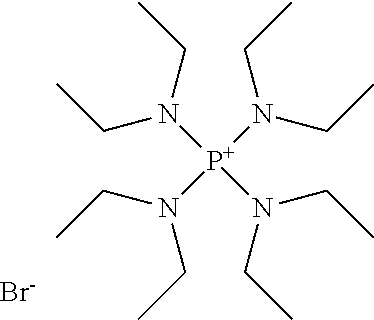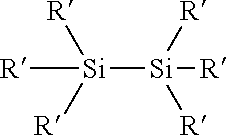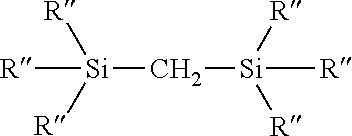Process for the production of organohydridochlorosilanes
a technology of hydridochlorosilane and process, which is applied in the direction of organic chemistry, chemistry apparatus and processes, and group 4/14 element organic compounds, etc., can solve the problems of not being able to disclose a practical, economically reasonable or sustainable industrial process for the synthesis of such building blocks
- Summary
- Abstract
- Description
- Claims
- Application Information
AI Technical Summary
Benefits of technology
Problems solved by technology
Method used
Image
Examples
example 1
[0262]LiH (3.0 mmol), Me2SiCl2 (1.7 mmol), tetraglyme (0.35 ml) and catalytic amounts of n-Bu4PCl (0.02 mmol) were placed in an NMR tube cooled to −196° C. (liquid nitrogen). After evacuation the NMR tube was sealed and warmed to room temperature (r.t.). The starting materials reacted upon heating the sample, and the reaction course of the chlorosilane reduction / redistribution reaction was monitored by NMR spectroscopy.
TABLE 280°120°120°120°no.silaneC., 0.25 hC., +2 hC., +2.5 hC., +6 hIMe2SiH231354755IIMe2SiCl2572073IIIMe2SiHCl12454642
[0263]As can be seen from Table 2, the formation of hydridosilane Me2SiH2 I was steadily increasing with increasing reaction temperature and time. The maximum amount of chlorosilane Me2SiHCl III formed by redistribution of hydridosilane I with dichlorosilane II was about 46 mol %. At 120° C. / 10 h the molar amount of Me2SiCl2 was reduced to only 3%, thus being hardly available for further redistribution with Me2SiH2, present in an amount of 55 mol-% und...
example 2
[0264]The reaction was performed in an analogous manner to the reaction of Example 1 using diglyme as solvent.
[0265]Table 3 covers the experimental findings of running the reaction as described. The yield of the target compound III was 55% at 120° C. / 2 h.
TABLE 380°120°120°120°no.silaneC., 0.25 hC., +2 hC., +2.5 hC., +6 hIMe2SiH237243645IIMe2SiCl25121135IIIMe2SiHCl12555150
example 3
[0266]The reaction was performed in full analogy to the reactions of the Examples 1 and 2 using 1,4-dioxane as solvent. Table 4 covers the experimental findings of running the reaction as described. In comparison to the reactions in tetraglyme (Example 1) and diglyme (Example 2), the redistribution in 1,4-dioxane required longer reaction times, but finally gave comparable results.
TABLE 4no.silane120° C., +2 h120° C., +2.5 h120° C., +6 h120° C., +21 h120° C., +24 h120° C., +60 hIMe2SiH2474138343435IIMe2SiCl242352414108IIIMe2SiHCl112438525657
PUM
| Property | Measurement | Unit |
|---|---|---|
| temperature | aaaaa | aaaaa |
| temperatures | aaaaa | aaaaa |
| total weight | aaaaa | aaaaa |
Abstract
Description
Claims
Application Information
 Login to View More
Login to View More - R&D
- Intellectual Property
- Life Sciences
- Materials
- Tech Scout
- Unparalleled Data Quality
- Higher Quality Content
- 60% Fewer Hallucinations
Browse by: Latest US Patents, China's latest patents, Technical Efficacy Thesaurus, Application Domain, Technology Topic, Popular Technical Reports.
© 2025 PatSnap. All rights reserved.Legal|Privacy policy|Modern Slavery Act Transparency Statement|Sitemap|About US| Contact US: help@patsnap.com



